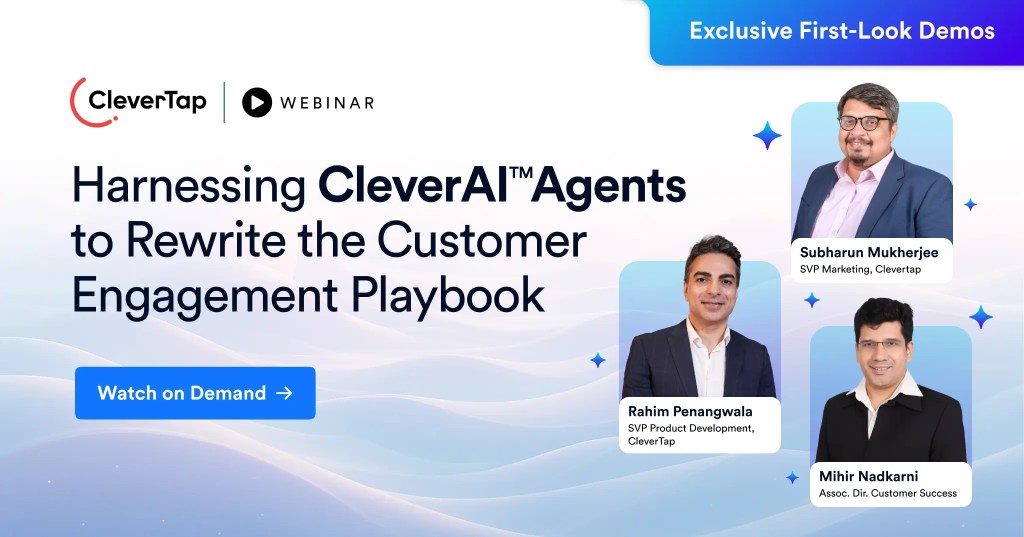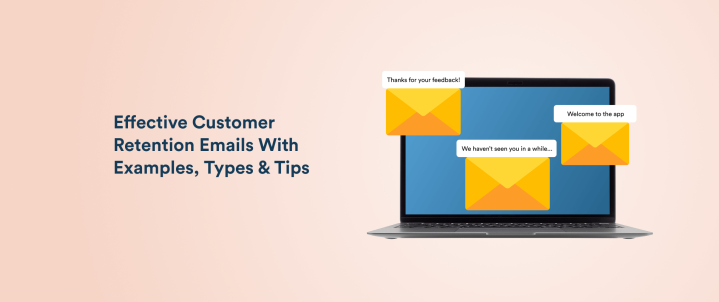Customer retention is as important, if not more, than acquiring new ones. Businesses often get so tied up in new lead generation via email marketing that they forget about existing ones.
Marketers should invest in retention email strategies to avoid the risk of churning disengaged customers. Increasing customer retention rates by 5% can increase profits by 25% to 95%, making retention emails a highly profitable channel.
This blog covers tips and best practices for successful customer retention email strategies. It also explores nine different examples of retention emails from real brands and analyzes what makes them work.
What Are Customer Retention Emails?
A customer retention email is an email sent to an existing customer to keep them engaged and satisfied. The purpose is to encourage customers to make repeat purchases, thus increasing brand loyalty and reducing churn rate.
Retention emails play a major role in the post-purchase stages of the customer lifecycle. They reinforce your brand values and offerings, gather customer feedback, and reward loyal customers, thus deepening long-term relationships.
Why Retention Emails Matter
Email marketing is a powerful method for acquiring and retaining customers. However, customer acquisition costs five to seven times more than the amount spent on retaining them. With an email marketing ROI of $36 for every dollar spent, businesses should consider investing more in customer retention email marketing.
Customer retention emails can improve engagement rates by delivering personalized content, recommending relevant products, and conducting timely check-ins. Brands can utilize retention email marketing to stay top-of-mind and deliver content matching user intent to foster brand loyalty.
Benefits of a Strong Retention Email Strategy
Incorporating retention emails as a marketing strategy comes with the following benefits:
- Higher Engagement: Retention emails are generally triggered based on user behavior, action, or inaction. They land periodically in your customer’s inbox and are more likely to drive engagement because they are aligned with your users’ needs and interests.
- Repeat Purchases: These emails tend to nudge repeat purchases by recommending similar products based on user behavior and purchase history.
- Lower Churn Rate: A good retention email strategy includes identifying inactive users and grouping them using predictive segmentation. Email sequences are set up for re-engagement, lowering the churn rate.
- Better Customer Insights: Disengaged users might have changed their preferences. Using retention emails for exit surveys or updated customer preferences in terms of content, communication channels, and buyer behavior equips the brand to target these customers better.
- Cost Savings: Retention emails help reduce customer acquisition costs by re-engaging existing customers, who are more cost-effective to retain than acquiring new ones.
- Customer Loyalty: Consistent, value-driven retention emails build trust and familiarity, reinforcing why a customer chose the brand in the first place.
11 Must-Have Retention Emails With Examples
Let’s have a look at nine retention email examples and analyze why they work.
1. Welcome Emails
A welcome email is often the first communication your user receives from the business. It is the perfect opportunity to make a good first impression. Use welcome emails to greet new users and set the tone for the relationship they will share with your brand.
Address the new users by their first names, but do not let that be the only form of personalization these emails provide. Brands can offer limited-time exclusive access to premium products or a free trial to get started. Provide clear next steps and maintain brand voice.
Example: Headspace
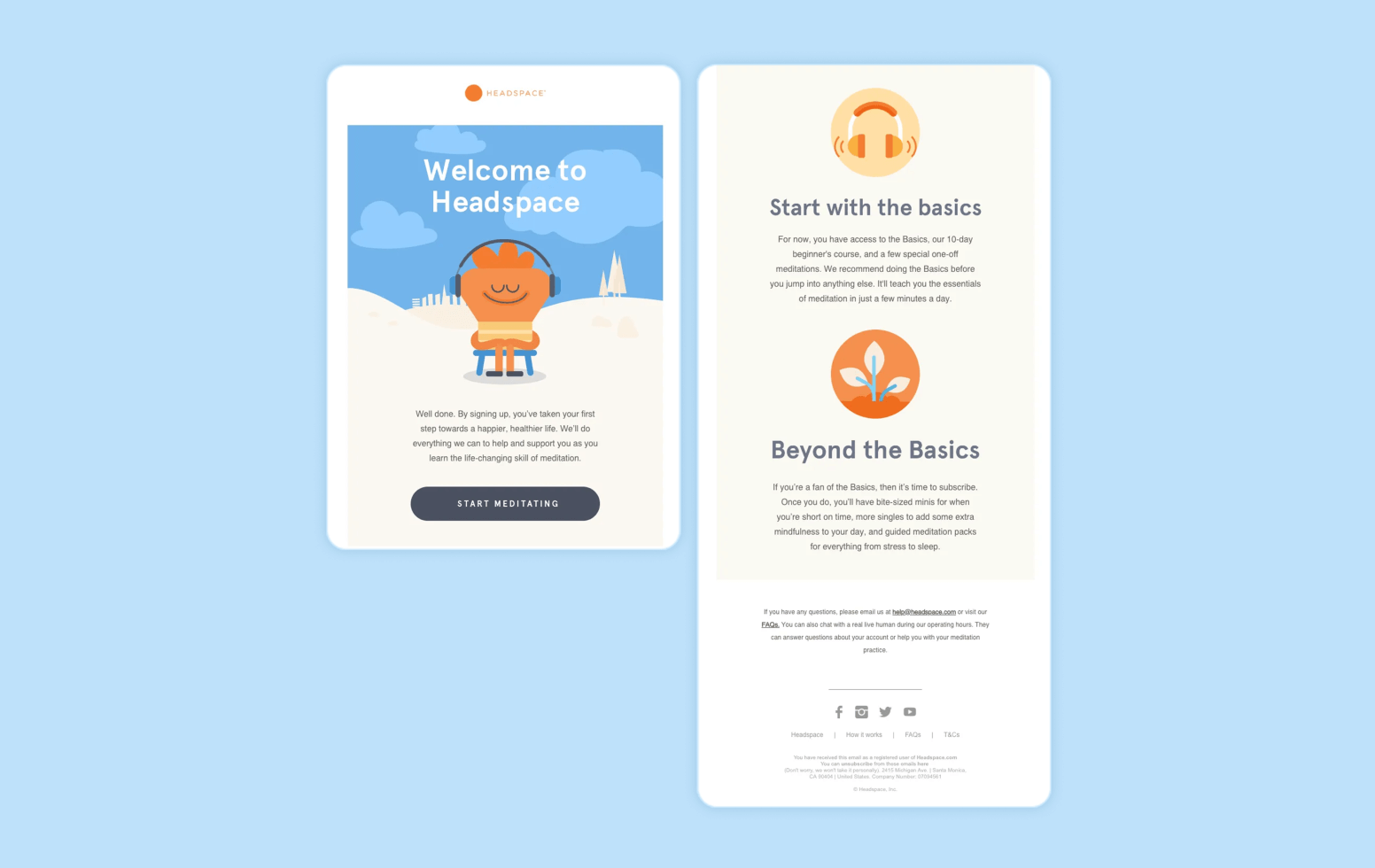
Why it works:
- The use of calming imagery aligns with a brand that specializes in mental health.
- The content is distributed into bite-sized pieces for better readability.
- Clear next steps and plan details that the user can choose based on their preference.
- A clear and hard-to-miss CTA nudging the user to begin their first session.
2. Onboarding Emails
An onboarding email provides a step-by-step guide and the next actions for a new user. These steps help users make the most of the product or service and act as a helping hand before they explore the offerings on their own.
Trigger onboarding emails based on user actions or behavior, such as a new sign-up, inactivity after signing up, or once the user has reached a certain milestone in the initial product journey. Onboarding emails generally contain helpful resources that enable users to achieve early value.
Example: Etsy
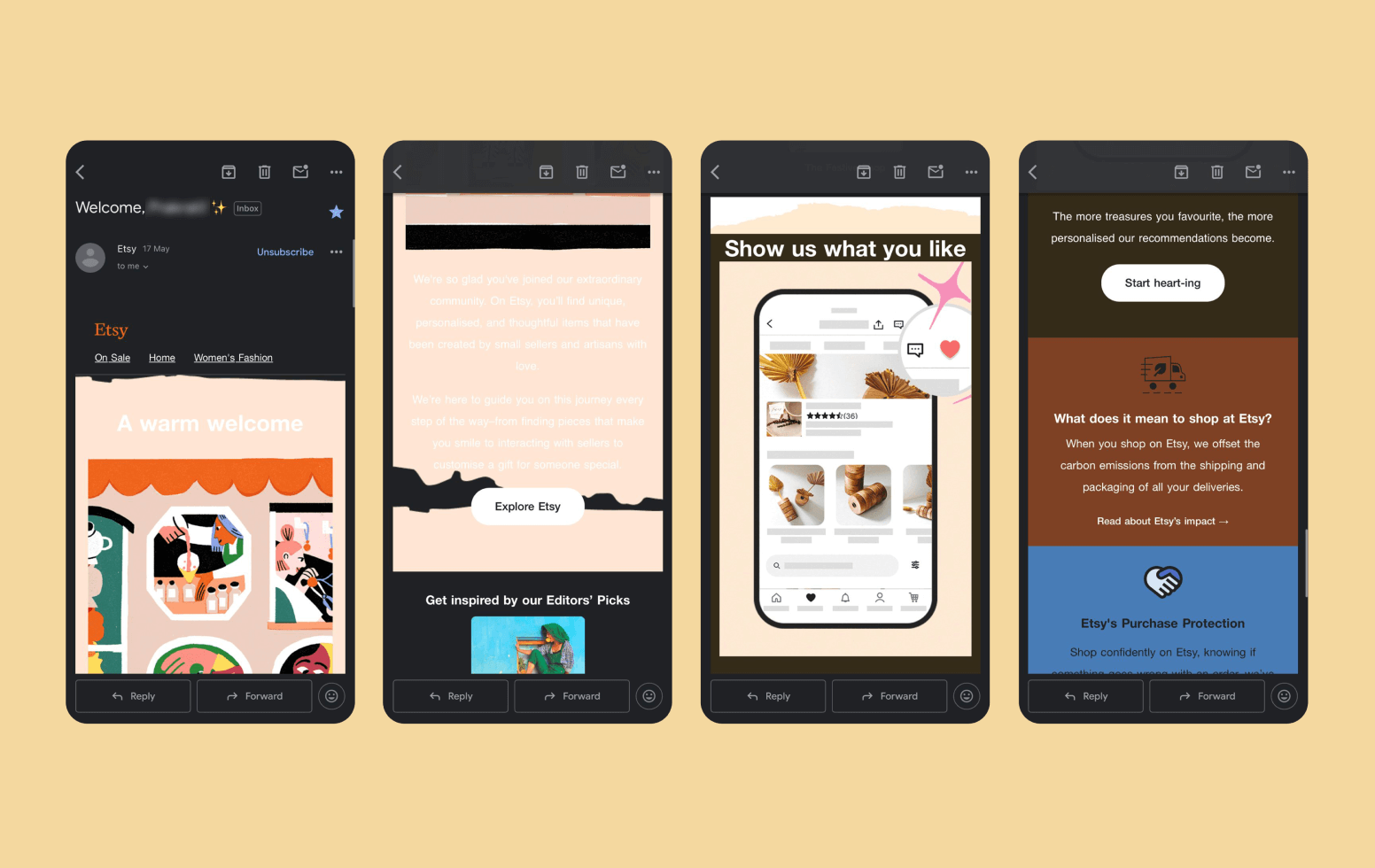
Why it works:
- Contains a clear step-by-step guide to start using Etsy
- Encourages the user to explore the app to get maximum value
- Provides tips and tricks to get started
3. Engagement Emails
Engagement emails keep users engaged with value-driven content. These emails may be sent as email newsletters and contain feature highlights resonating with user needs to promote active usage. The emails are sent based on user behavior triggers, like an activity streak of seven days.
Example: Duolingo
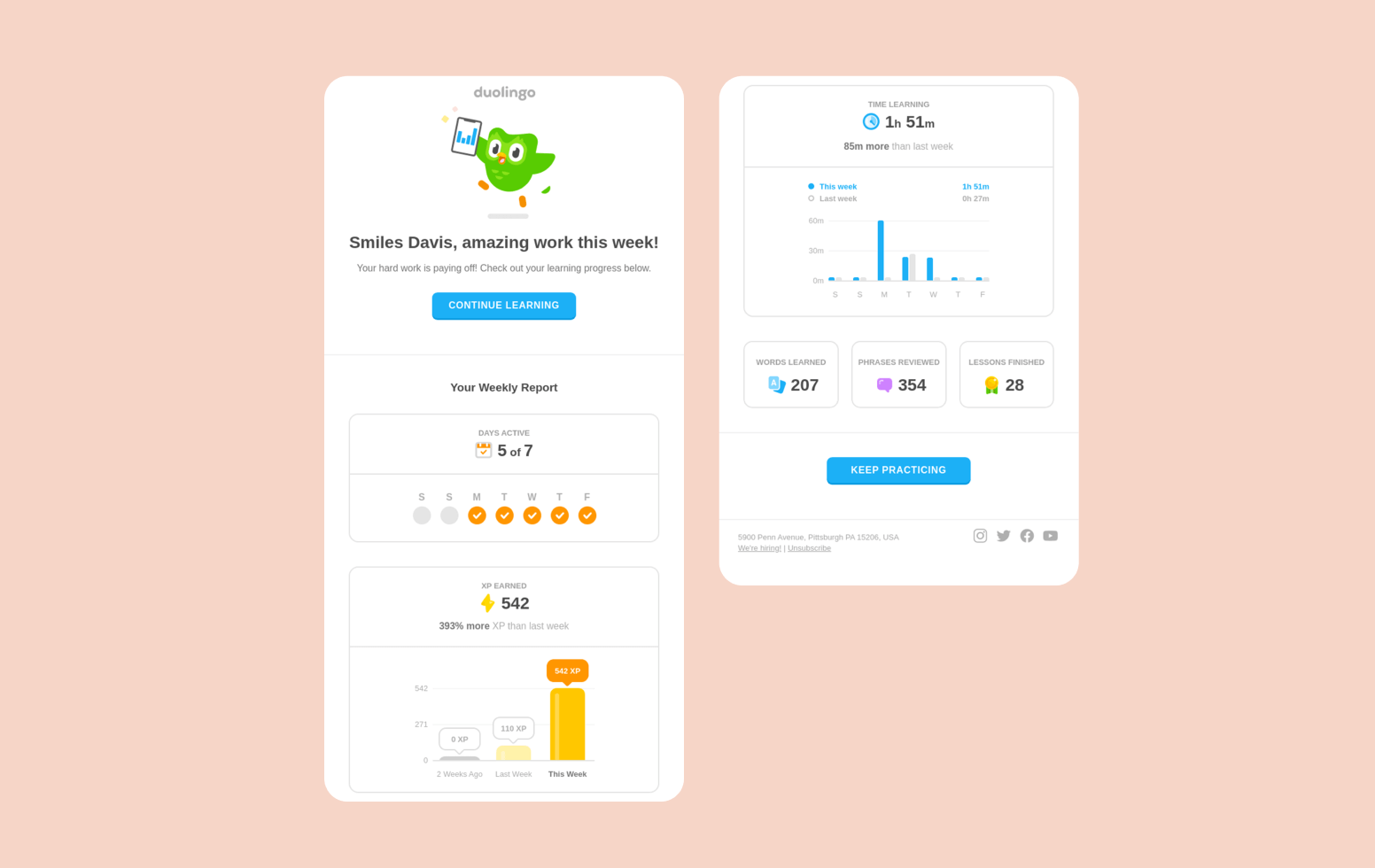
Why it works:
- An element of gamification with streak updates keeps users engaged
- Words of encouragement and motivation to unlock new levels
- Nudges the user for daily app usage to maintain the streak
4. Re-engagement Emails
Re-engagement emails target inactive customers with content that incentivises them to start using the product or service again. These win-back emails contain incentives like special offers or promo codes, personalized messages to re-capture attention, or feedback requests that show the brand is open to suggestions for improvement.
Example: Grammarly

Why it works:
- The weekly updates make users feel good about what they have accomplished
- Use of funny elements to recapture attention and urge users to use the app again
- Intelligent use of visuals to portray how Grammarly can correct spelling mistakes
5. Feedback and Survey Emails
Taking customer feedback and acting on it is an essential element of building brand loyalty and retaining customers. Feedback and survey emails showcase the brand’s willingness to make its customers feel heard. Use these emails to conduct short and easy-to-complete surveys, provide incentives for surveys or feedback, and don’t forget to express appreciation for trusting your business.
Example: Uber
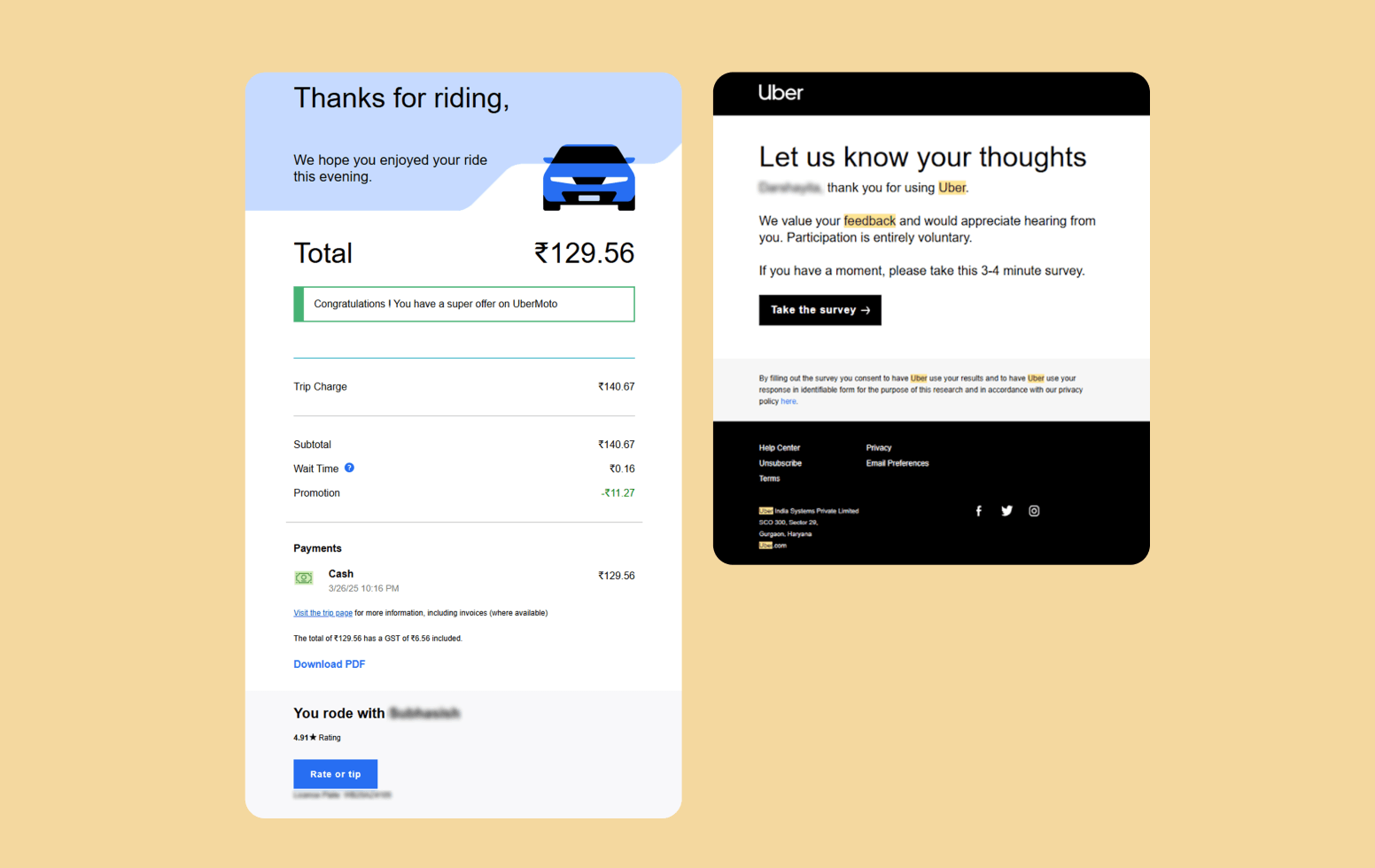
Why it works:
- The subject line clearly states the purpose of the email
- Begins with thanking the user for availing their cab service
- Uses personalization with details of the car ride, the driver, and the user
- Clear CTA for leaving a rating and feedback
- Short and easy-to-finish surveys
6. Thank You and Appreciation Emails
Customers like to feel appreciated and seen. A simple personalized thank-you note from the business can go a long way in deepening customer relationships and ensuring a positive experience. Brands can go a step further and show how thankful they are in the form of exclusive offers or access to premium content.
Example: Unsplash
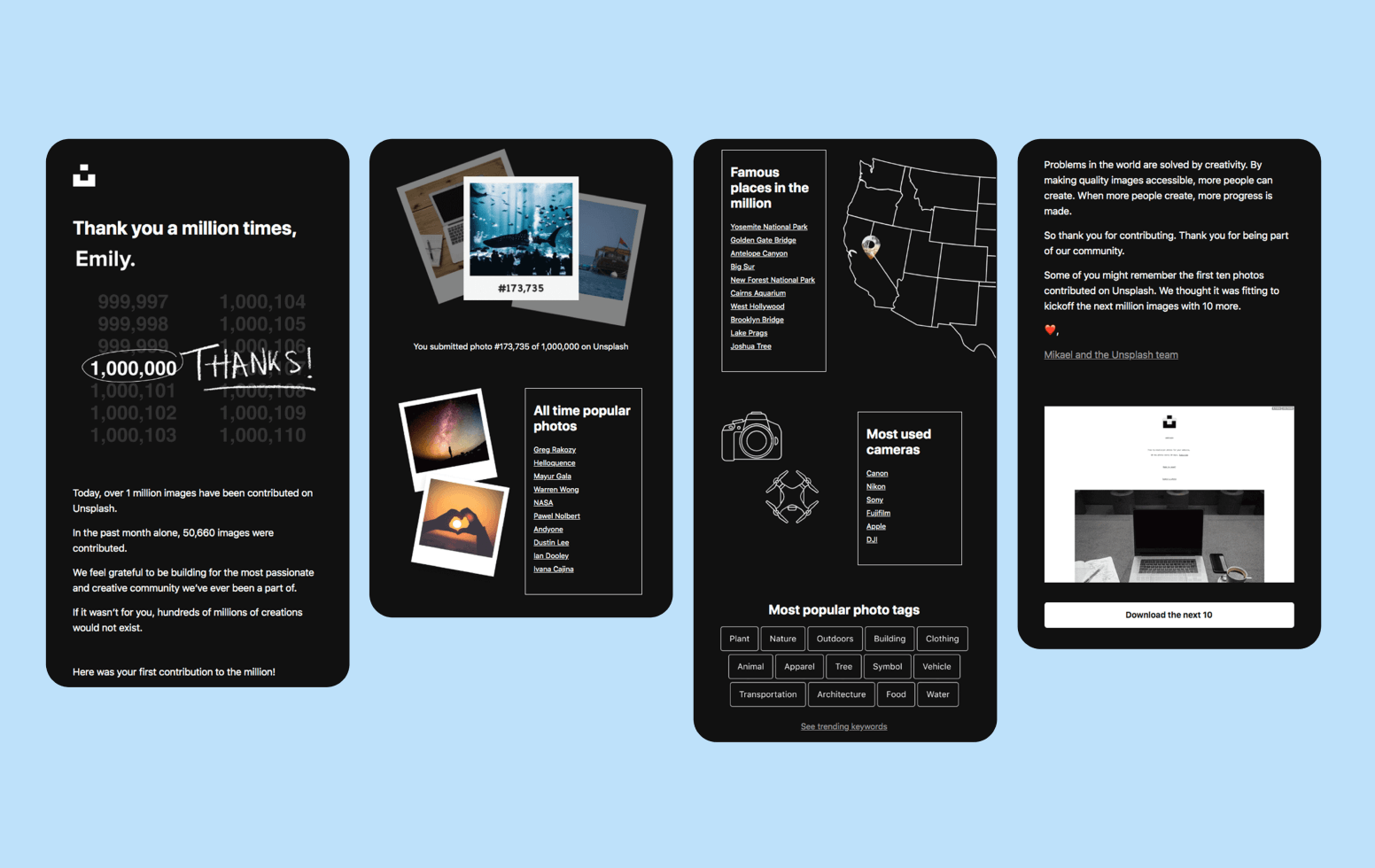
Why it works:
- The thanks offered are genuine, with no sales ploy in disguise
- Personalized with the recipient’s first photo upload featured
- Contains relevant content for the creative community, highlighting the most popular categories and places tagged
7. Review Request Emails
Review request emails are a powerful form of retention email marketing that invite satisfied customers to share their experiences publicly. These emails not only reinforce positive sentiment but also help attract new users through authentic testimonials and social proof.
They typically work best when sent shortly after a positive interaction, milestone, or purchase. The tone should be friendly and appreciative, with a clear CTA that makes it easy for customers to submit their reviews.
Example: TradeGecko

Why it works:
- Opens with a playful and encouraging message (“Hey superstar!”), establishing a warm tone.
- Personalizes the message by referencing the user’s previous engagement with the brand.
- Clearly explains the impact of reviews for the brand (“helps us improve and help others”).
- The CTA (“Write a Review on GetApp”) is bold, centered, and easily clickable.
8. Special Occasion Emails
Customers expect to hear from their favorite brands on special occasions like their birthdays, anniversaries, and global holidays. Personalized emails, delivered timely on such days, show that you care enough about your customers to put in that extra effort.
Example: Prezi AI
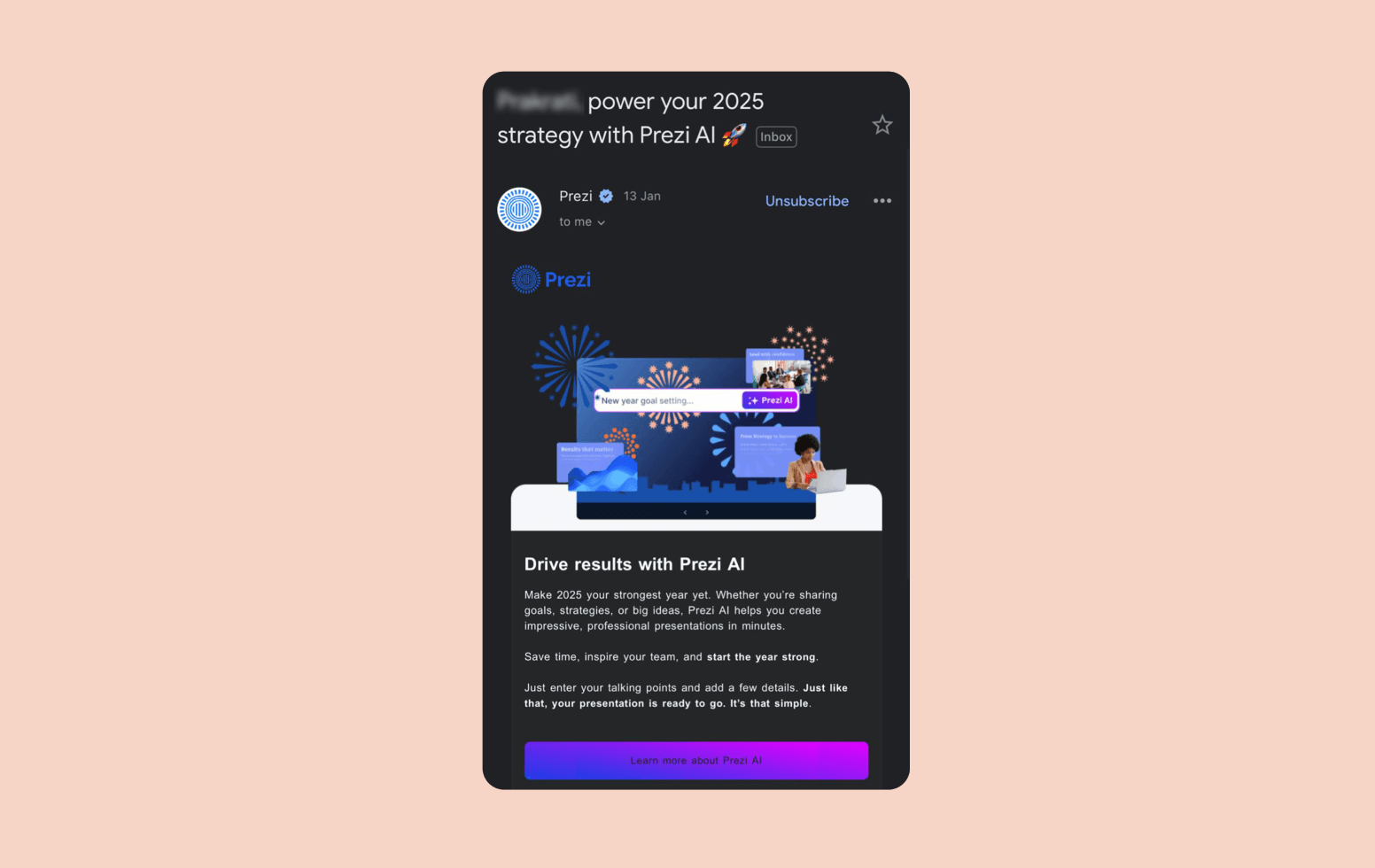
Why it works:
- Encourages the recipient to start the new year on a positive note
- Clearly mentions the value propositions that Prezi AI provides
- Guides the recipient on how to use the application
9. Referral Emails
Referral emails serve a dual purpose. They attract new customers by providing incentives to the existing ones. When a loyal user recommends a brand to their peers, the business also gets free word-of-mouth marketing. The best practices for writing referral emails include clearly mentioning the rewards, making it easy to share the referral code without any friction, and creating a sense of urgency with limited-time offers.
Example: Starbucks

Why it works:
- The messaging is clear and straightforward
- The image used gives a friendly vibe and is aligned with the brand, both girls have Starbucks orders in front of them
- Clearly mentions the reward for referral as “Get 20% OFF at Starbucks”
10. Cross-Sell and Up-Sell Emails
These retention email marketing tactics recommend complementary or upgraded products based on previous purchases. Effective cross-sell or up-sell emails use browsing or transaction history to deliver personalized offers that increase average order value while reinforcing product value.
Example: Netflix
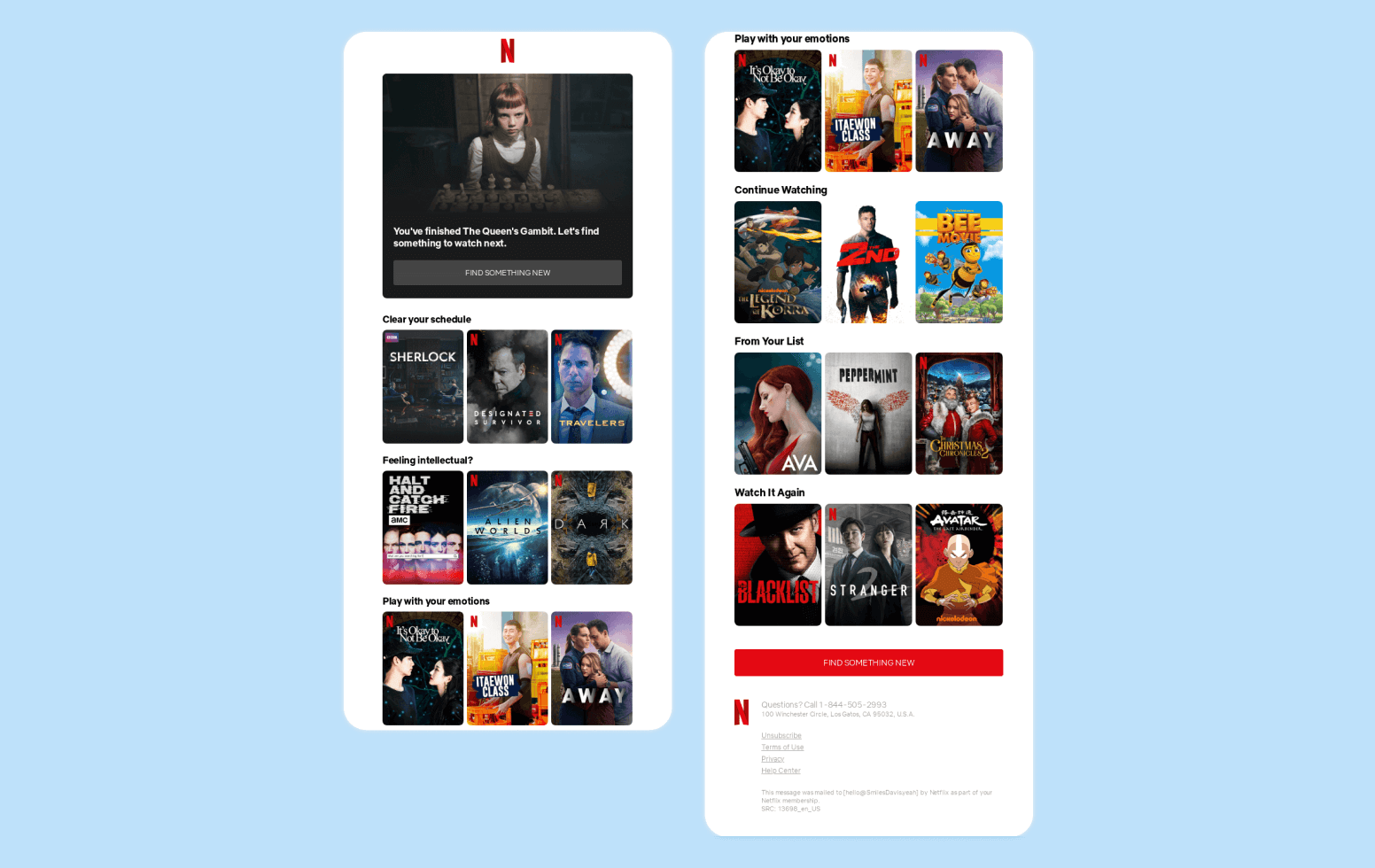
Why it works:
- Recommends new shows based on viewing history
- Uses smart visuals and teaser lines to increase click-through
- Keeps users engaged with more personalized value
11. Abandoned Cart Emails
Cart abandonment emails are crafted to recover potentially lost sales. The user has added items to his cart but has not checked out. Possible reasons for the incomplete purchase could be a long checkout process with friction, or the customer is waiting for a price drop, or some offers and discounts. They might have also simply changed their minds about buying the product.
Incorporate attractive and impactful product visuals, hooks for incentives, and urgency cues in the email content. The email should nudge the users to complete their purchase.
Example: Amazon
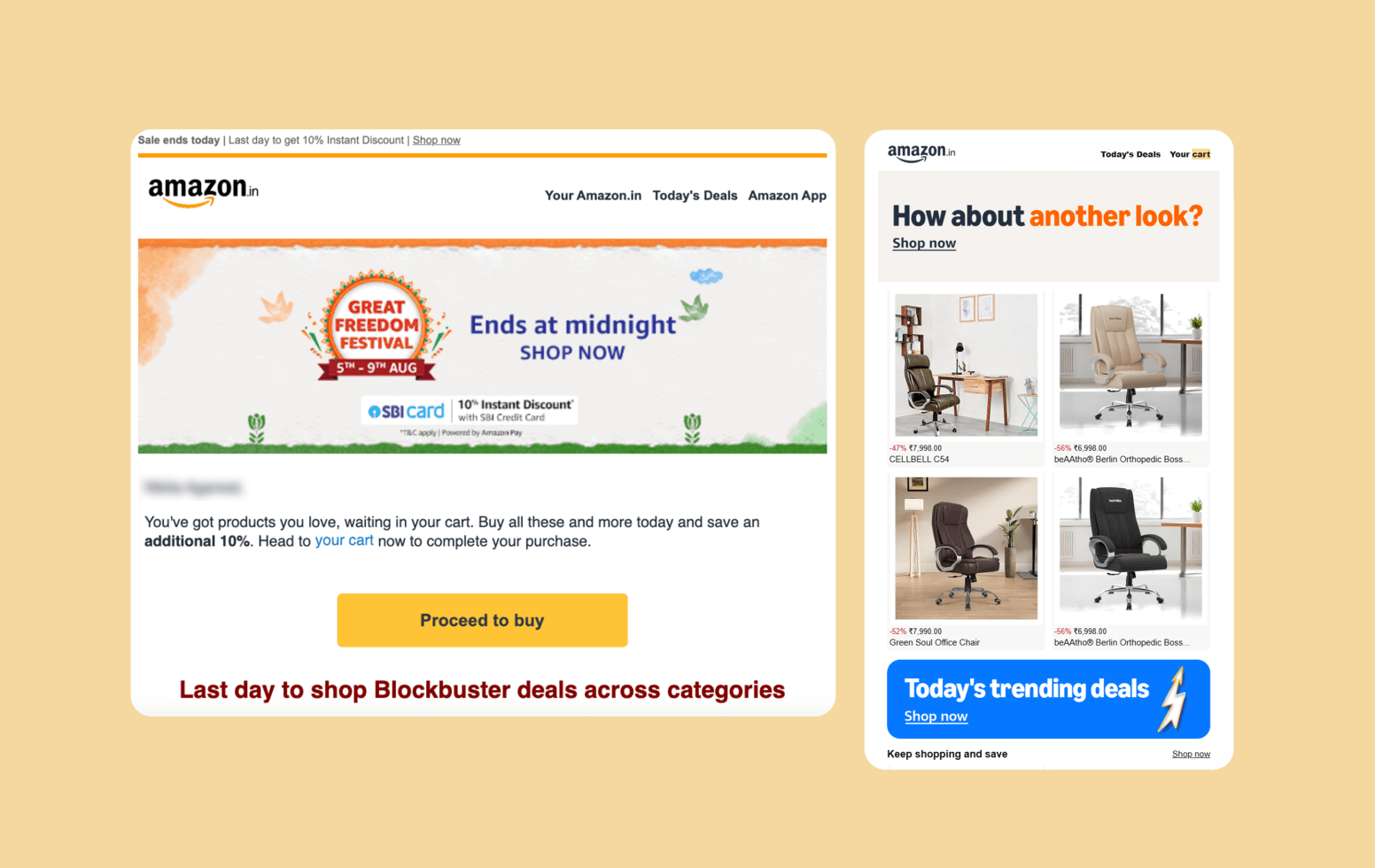
Why it works:
- Provides price drop alerts as percentages for items in the user’s cart
- Instills urgency by mentioning that it is the last day to avail of blockbuster deals
- Uses images of the items in the cart so that the user easily remembers and visualizes the items they might still want
Crafting High-Performing Retention Emails
Pay special attention to the following elements of the retention emails to achieve better email marketing conversion rates.
Write Subject Lines That Get Opened
The email subject line is the first thing the recipient sees in their inbox. It provides the opportunity for brands to leave a good impression. The email content will not matter if the subject line cannot make the reader curious enough to open the email. Follow these best practices to write subject lines for emails that get opened.
- Create a sense of urgency or a fear of missing out (FOMO) by using time-sensitive language. Example: Don’t miss these exclusive deals!
- Refer to recent user action to hyper-personalize the subject line.
- Pique the reader’s curiosity to create an information gap that the email content fills.
- Perform A/B testing or Multivariate testing of different elements in the subject line. Test subject lines with emojis, variable lengths, and different tone of voice to see which performs better.
Read our blog to learn more about FOMO marketing strategies.
Personalize Beyond First Names
Personalization does not end with mentioning the receiver’s first name in the emails. Customers now expect emails with deep personalization that consider their interests, needs, and send content relevant to their buyer journey. Increase conversion rate by personalizing your retention emails in the following ways:
- Use behavioral and action-based triggers like cart abandonment, viewed products, or inactivity to send relevant and timely emails that match the user’s interests.
- Segment the audience based on their lifecycle stages to deliver personalized content. Send onboarding emails to new users, product updates, and feature releases to existing ones, and promo codes or discounts to inactive users for re-engagement.
- Incorporate dynamic content blocks in emails to show varying product recommendations, offers, or messaging to different email segments.
Structure the Email Body
You do not want an outstanding subject line that makes the reader curious to end up reading an email body that under-delivers. A cluttered email results in readers losing interest and dropping off, while a well-structured email holds attention and directs the reader’s focus toward the CTA. Here are some tips for better email structures.
- Use the visual hierarchy method by placing the most important message or offer at the top.
- Make generous and strategic use of white space to guide the eye, make the CTA stand out, and avoid visual overload.
- Each email should focus on a single objective, as multiple calls to action can overwhelm the reader.
Read more about email copywriting with tips and examples to boost opens and clicks.
Create High-Converting CTAs
Calls-to-action (CTAs) play a critical role in converting inactive customers by nudging them to take action. Don’t miss the opportunity of re-engaging these customers with a weak CTA. Follow these tips to write high-converting CTAs.
- Use action-oriented and benefit-driven language. Example: Redeem your Buy 1 Get 1 Offer.
- Position the CTA button above the digital fold and repeat it at the end for easy access.
- Make the CTA button visually distinct by using contrasting colors that align with brand guidelines. Make the corners rounded and provide ample padding.
Optimize for Mobile Responsiveness
Retention emails must be designed to be mobile-friendly, as most users open emails on their mobile devices. Here are some best practices to ensure mobile-friendly emails that are also functional across all devices.
- Use legible font sizes, large enough to be read without zooming in.
- Use a single-column layout to make the content adapt easily on a narrow screen.
- Give the CTA buttons enough vertical padding, making them easy to tap.
- Use compressed images to reduce load time and also provide descriptive alt text, in case the image does not load.
Read more email marketing best practices to boost your email campaigns.
8 Expert Tips to Boost Retention Email Performance
Mentioned below are eight practical and action-oriented tips to drive your retention email marketing performance.
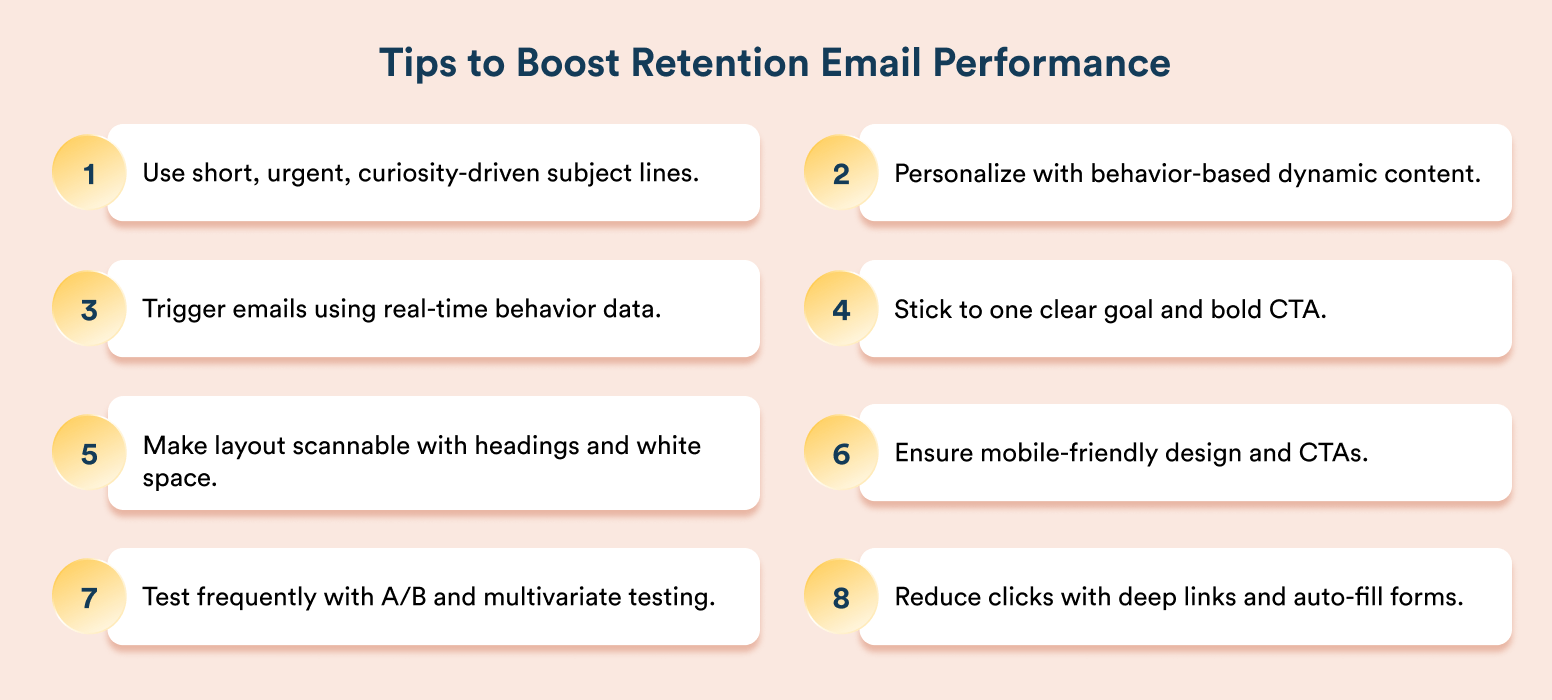
- Keep the subject line short, clear, and crisp by using a maximum of 50 characters. Use language that creates a sense of urgency and makes the reader curious enough to open the email.
- Use the dynamic content slabs to personalize content based on user behavior.
- Optimize email send times and frequency by using platforms that analyze real-time behavior to trigger email automation workflows.
- Stick to one goal per email to maintain clarity on the CTA. Ensure the CTA is designed, lettering, and the message is bold and clear.
- Break down the email design into easily scannable segments. Use bullet points, bold headings, and strategic placement of white space to guide the reader’s eye towards the CTA.
- Format and optimize the email design and content for mobile responsiveness. Use large fonts and thumb-friendly CTAs.
- Conduct frequent and strategic testing to find what works best. Supplement A/B testing with multivariate testing to test different email elements.
- Deep-link to apps, include auto-fill forms, and reduce the number of clicks to conversion to remove friction.
Create retention boosting emails this holiday season. Get inspired by these examples of 4th of July email campaigns.
Measuring Success and Optimizing Over Time
Continuously track the performance of your customer retention emails and optimize with each iteration. Monitor these key email performance metrics.
- Open Rate: Denotes the percentage of recipients who open the email, thus indicating the effectiveness of the subject line.
- Click-Through Rate: The percentage of recipients who clicked on at least one link in the retention email.
- Conversion Rate: Percentage of users who performed a desired action, like completing a purchase using a link in the email.
- Unsubscribe Rate: The number of recipients who opt out of the mailing list after receiving the email.
Perform A/B and Multivariate Testing on different elements of the email to come up with versions that work best for your customer retention email marketing strategy. Marketers can test the following parts of an email:
- Subject lines
- CTAs
- Content layouts
- Design
Follow a data-driven approach to email marketing and work with statistically significant sample sizes and evaluate long-term metrics like revenue, conversion, and retention rates.
Implement a continuous improvement loop by using feedback forms, short surveys, net promoter score (NPS), and behavior trend analysis. Ask customers for updated content preferences to optimize campaigns accordingly.
How CleverTap Can Help With Your Email Marketing Retention Strategies
CleverTap, an all-in-one customer engagement platform with an advanced email marketing automation tool, helps marketers carry out customer retention email campaigns. Businesses have seen an increase in conversion rate by 30%, click-through rate by 60%, and open rate by 40% after using CleverTap.
1. Smart Email Creation & Design
CleverTap streamlines email creation with a visual drag-and-drop email editor, HTML support, and AMP for interactive elements like forms and product carousels. These are all optimized for any device or email client. Templates can be saved and reused via a centralized Content Manager, and real-time previews ensure flawless rendering across platforms.
2. Personalization with AI & Real-Time Context
Campaigns can be personalized using behavioral, profile, and location data. Clever.AI’s Scribe generates emotionally resonant subject lines and headers to maximize engagement. Predictive segmentation and RFM models help target high-value and at-risk users with tailored content and offers.
Read more about AI in email marketing and the tools that make it possible.
3. Automated Journeys for Every Lifecycle Stage
CleverTap supports journey-based automation, enabling marketers to trigger emails based on user behavior like cart abandonment or inactivity. Its AI engine, IntelliNODE, continuously tests and optimizes journey paths in real time, ensuring users receive the most effective messages at each stage.
Learn how to build customer lifecycle based email campaigns.
4. Testing & Send-Time Optimization
Run A/B and multivariate tests to refine content, layout, and CTAs. CleverTap also determines the best time to send emails to each user in your email list based on engagement history, helping improve open and response rates without manual effort.
5. Real-Time Analytics & Performance Tracking
Gain deep insights into email performance with real-time metrics on opens, clicks, bounces, and inbox placement. Spam diagnostics and automated UTM tagging further support optimization and impact analysis.
6. Enterprise-Grade Deliverability & Controls
CleverTap offers flexible ESP integration, dedicated IP support, and comprehensive deliverability infrastructure, including IP warm-up, SPF/DKIM, and reputation monitoring. An out-of-the-box Email Preference Center allows users to manage subscriptions, helping reduce churn and improve engagement quality.
7. Enhanced Email Visibility & Attribution
CleverTap ensures emails render correctly and reach their audience with previews across 90+ clients and pre-launch spam diagnostics to catch deliverability issues early. It also auto-appends UTM parameters, enabling precise tracking of post-click behavior for better attribution and retention optimization.
Personalize and Segment Your Retention Emails for Maximum Conversion.
Retain More Customers with the Right Emails
Retention emails tap into a customer segment that has already shown interest once. The trick lies in using the strategies mentioned in this blog to re-engage these customers and encourage them to make repeat purchases.
A robust retention email marketing strategy will use a platform that provides advanced capabilities like personalization, segmentation, A/B and multivariate testing, and email automation. Make a note of the examples shared in this article and why they work. Try to implement those components in your upcoming retention emails.
Ready to elevate your retention email marketing strategy? Book a demo with CleverTap and see how you can turn more one-time users into loyal customers.
Shivkumar M 
Head Product Launches, Adoption, & Evangelism.Expert in cross channel marketing strategies & platforms.
Free Customer Engagement Guides
Join our newsletter for actionable tips and proven strategies to grow your business and engage your customers.












































